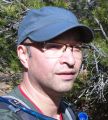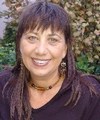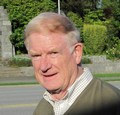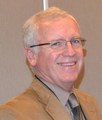GEORGIA BASIN INTER-REGIONAL EDUCATION INITIATIVE: “The IREI helps the champions in each region understand what the other regions are doing, what works and what does not,” stated Mike Tanner, Director, Partnership for Water Sustainability in British Columbia

“We are working with practitioners involved in water resources functions to foster integrated protection and management strategies through enhancement of practitioner expertise (i.e. “developing talent”), and through further evolution and delivery of program elements developed under the umbrella of the Water Sustainability Action Plan for British Columbia,” stated Mike Tanner. “The IREI provides local governments with a mechanism for sharing and learning from each other through collaborative processes.”
Changing the Way We Do Business in British Columbia: “EAP – the Ecological Accounting Process – is a whole-system view of watersheds that assesses hydrology in order to accurately describe ecological services,” states Tim Pringle

The Nanaimo Water Symposium will showcase the first demonstration applications of the Ecological Accounting Process (EAP) to assess ‘watershed worth’. “Looking through the ‘worth lens’ has led to a fundamental shift in the EAP approach: place less emphasis on monetization of ecological services; instead, focus on the investment of resources as well as aspirations of motivated stakeholders,” states Tim Pringle.
“NALT uses the tools of land trusts to promote and protect the natural values of land in the Nanaimo area,” says Paul Chapman, Acting Executive Director

The Nanaimo River Watershed is a principal focus of the Nanaimo Area & Land Trust (NALT). “In 2011, NALT was the catalyst for bringing together a group of stakeholders to create the Nanaimo River Watershed Roundtable,” stated Paul Chapman. “Through the Roundtable, a group of stakeholders in the watershed who in the past might not have convened at the same table, have been able to gather and share information and where appropriate resources for the stewardship of the watershed and all the values, environmental, social and economic it supports.”
FLASHBACK TO 2016: “When developing the Bowker Creek Blueprint, we used stylized graphics to help the community visualize what is possible, even in a highly developed watershed,” stated Jody Watson, Capital Region District

We all learn from stories and the most compelling ones are based on the experiences of those who are leading in their communities. Local government champions on the east coast of Vancouver Island are sharing and learning from each other through inter-regional collaboration. “For the Bowker Creek watershed, we realized that the community, especially the youth, had no memory of Bowker Creek in a natural state because almost 70% of the creek was in pipes,” recalled Jody Watson. “we used stylized graphics to represent an open and above-ground creek.”
Report on Water Sustainability and the City (Dec 2017): “B.C.’s new Water Sustainability Act could increase local governments’ abilities to more sustainably manage local watersheds,” says report author Chistine Mettler, Canadian Freshwater Alliance

The Canadian Freshwater Alliance undertook research to determine what problems are affecting urban watersheds, why they’re happening, barriers local governments face in trying to address them, and how better supports could be developed under the province’s water framework. “Local governments play a large role when it comes to protecting watershed health. However, many watershed professionals working in local government feel stymied in their efforts to protect their local watersheds.” stated Christine Mettler.
Implementing the Water Balance Approach on Vancouver Island: Desired policy outcomes in transitioning drainage practice from “voodoo hydrology” to the Water Balance Methodolgy would be less flooding, less stream erosion, more streamflow when needed most ….and reduced life-cycle costs and risks!

Andy Reese coined the term Voodoo Hydrology in 2006 to describe drainage engineering and stormwater management practice. “We have for years relied upon common design methodologies and trusted their results. But, should we? It is an inexact science at best. We rely on judgment and guesswork,” states Andy Reese. He is an American water resources engineer & textbook author. “Perhaps, if we make enough estimates of enough factors, the errors will average out to the right answer. This is where voodoo really comes in handy.”
Asset Management for Sustainable Service Delivery: “The BC Framework makes the link between local government services, the infrastructure that supports the delivery of those services, and the health of watershed systems,” observes Wally Wells, Executive Director, Asset Management BC

“Asset management is a continuous process, not a discrete task,” states Wally Wells. “Too much emphasis is too often placed on the ‘Asset Management Plan.’ The PLAN is only a part of the overall process. The asset management process is a continuum. The process starts with the engineered assets that local governments provide. Communities will progress along the continuum incrementally as their understanding grows. By also accounting for and integrating the services that nature provides, over time communities can achieve the goal of Sustainable Service Delivery for watershed systems.”
FLASHBACK TO 2007: “It`s all about people, and most of all, it`s about involving the right people at the start,” stated Rob Lawrance, City of Nanaimo Environmental Planner, at the launch event in the Showcasing Green Infrastructure Series on Vancouver Island

In 2007, Rob Lawrance set the context and introduced the unifying themes for the three City of Nanaimo presentations. “Our participation in the 2007 Showcasing Innovation Series served as a catalyst for the City of Nanaimo to evaluate our progress to that date, and reflect on lessons learned from our experience in piloting innovation,” recalled Rob Lawrance. “The City of Nanaimo showcasing focus was on three policies that each addressed public concerns on different scales. A decade ago, each policy and application represented a ‘first’ for either the region or the City of Nanaimo.”
Water Stewardship in a Changing Climate: “In British Columbia, we are being challenged to re-assess our thinking regarding how we practice water management in the 21st century,” stated Eric Bonham, a founding member of the Partnership for Water Sustainability

“Future planners, engineers, scientists, politicians and citizens alike will be called upon to demonstrate both vision and pragmatism, working as a team towards consensus, commitment and collaboration for the common good. Such collaboration is essential and must cross all political and community boundaries given that climate change is no respecter of such creations. The Partnership has accepted this challenge and its implementation,” stated Eric Bonham.
CHANGE THE WAY WE DRAIN LAND ON VANCOUVER ISLAND: “The survival of Coho salmon in the Englishman River depends on a healthy Shelly Creek,” states Peter Law, Vice-President, Mid Vancouver Island Enhancement Society

“Community stewardship volunteers are demonstrating what it means to embrace ‘shared responsibility’ and take the initiative to lead by example. MVIHES secured funding from multiple agencies and developed the Shelly Creek Water Balance & Sediment Reduction Plan,” stated Peter Law. “The challenge for MVIHES is to facilitate the community’s journey from awareness to action, expressed as follows: Once a community as a whole acknowledges that there is a problem, and also understands why there is a problem, what will the community do about it?”

